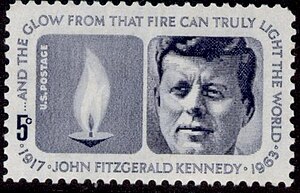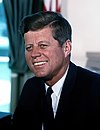
A postage stamp is a small piece of paper issued by a post office, postal administration, or other authorized vendors to customers who pay postage. Then the stamp is affixed to the face or address-side of any item of mail—an envelope or other postal cover —which they wish to send. The item is then processed by the postal system, where a postmark or cancellation mark—in modern usage indicating date and point of origin of mailing—is applied to the stamp and its left and right sides to prevent its reuse. Next the item is delivered to its addressee.
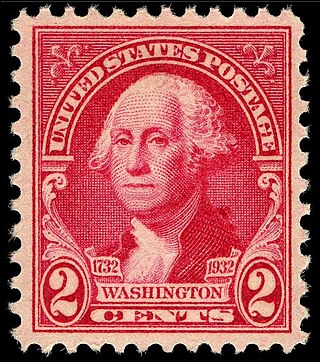
The Washington Bicentennial stamps of 1932 are postage stamps issued by the United States government in 1932 to commemorate the 200th anniversary of U.S. President George Washington's birth. Twelve stamps were issued as a collection, with each one depicting the President in a different period in his life.

Postal service in the United States began with the delivery of stampless letters whose cost was borne by the receiving person, later encompassed pre-paid letters carried by private mail carriers and provisional post offices, and culminated in a system of universal prepayment that required all letters to bear nationally issued adhesive postage stamps.
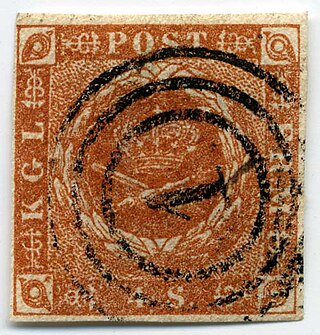
This is an overview of the postage stamps and postal history of Denmark.

The postage stamps and postal system of the Confederate States of America carried the mail of the Confederacy for a brief period in U.S. history. Early in 1861 when South Carolina no longer considered itself part of the Union and demanded that the U.S. Army abandon Fort Sumter, plans for a Confederate postal system were already underway. Indeed, the Confederate Post Office was established on February 21, 1861; and it was not until April 12 that the American Civil War officially began, when the Confederate Army fired upon U.S. soldiers who had refused to abandon the fort. However, the United States Post Office Department continued to handle the mail of the seceded states as usual during the first weeks of the war. It was not until June 1 that the Confederate Post Office took over collection and delivery, now faced with the task of providing postage stamps and mail services for its citizens.

The Trans-Mississippi Issue is a set of nine commemorative postage stamps issued by the United States to mark the 1898 Trans-Mississippi Exposition held in Omaha, Nebraska. The finely engraved stamps depict various scenes of the West and are presently valued much by collectors. This was only the second commemorative issue offered by the U.S. Post Office and closely followed the pattern of its predecessor, the Columbian Exposition series of 1893: both sets appeared in conjunction with important international world's fairs; both offered a wide range of stamp denominations; both adopted the double-width stamp format to accommodate pictorial tableaux.

The John F. Kennedy Eternal Flame is a presidential memorial at the grave site of assassinated United States President John F. Kennedy, in Arlington National Cemetery in Virginia. This permanent site replaced a temporary grave and eternal flame used at the time of Kennedy's state funeral on November 25, 1963, three days after his assassination. The site was designed by architect John Carl Warnecke, a longtime friend of Kennedy. The permanent John F. Kennedy Eternal Flame grave site was consecrated and opened to the public on March 15, 1967.

The Presidential Issue, nicknamed the Prexies by collectors, is the series of definitive postage stamps issued in the United States in 1938, featuring all 29 U.S. presidents who were in office between 1789 and 1928, from George Washington to Calvin Coolidge. The presidents appear as small profile busts printed in solid-color designs through 50¢, and then as black on white images surrounded by colored lettering and ornamentation for $1, $2, and $5 values. Additional stamps in fractional-cent denominations offer busts of Benjamin Franklin and Martha Washington, as well as an engraving of the White House. With its total of 32 stamps, this was the largest definitive series yet issued by the U. S. Post Office.
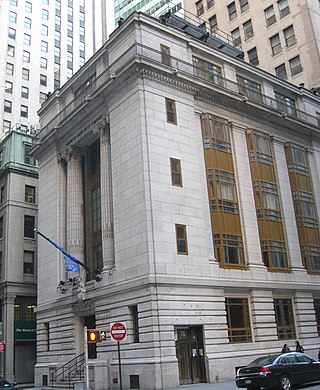
American Banknote Corporation, trading as ABCorp, is an American corporation providing contract manufacturing and related services to the authentication, payment and secure access business sectors. Its history dates back to 1795 as a secure engraver and printer, and assisting the newly formed First Bank of the United States to design and produce more counterfeit resistant currency. The company has facilities in the United States, Canada, Australia, and New Zealand.
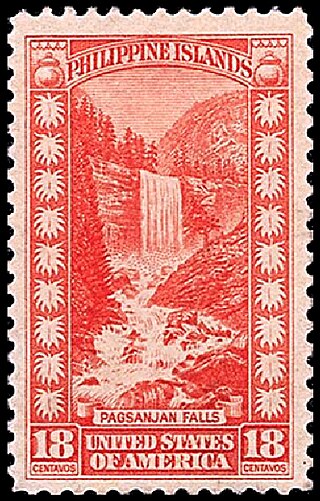
The Pagsanjan Falls stamp is a postage stamp, issued on May 3, 1932, which is notable for having an error. It is part of a set of seven stamps showing places of interest and landmarks in the Philippines, at that time a United States territory. It is a postage stamp design error printed in the United States and intended to display an image of Pagsanjan Falls, a tourist attraction in Laguna province in the Philippines. However, the image on the stamp is actually of Vernal Fall in Yosemite National Park, California. The stamp was withdrawn on November 17, 1932.
With the advent of robotic and human spaceflight a new era of American history had presented itself. Keeping with the tradition of honoring the country's history on U.S. postage stamps, the U.S. Post Office began commemorating the various events with its commemorative postage stamp issues. The first U.S. Postage issue to depict a U.S. space vehicle was issued in 1948, the Fort Bliss issue. The first issue to commemorate a space project by name was the ECHO I communications satellite commemorative issue of 1960. Next was the Project Mercury issue of 1962. As U.S. space exploration progressed a variety of other commemorative issues followed, many of which bear accurate depictions of satellites, space capsules, Apollo Lunar Modules, space suits, and other items of interest.
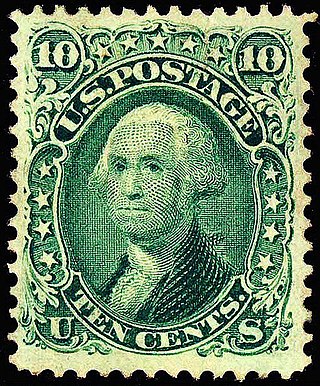
Presidents of the United States have frequently appeared on U.S. postage stamps since the mid-19th century. The United States Post Office Department released its first two postage stamps in 1847, featuring George Washington on one, and Benjamin Franklin on the other. The advent of presidents on postage stamps has been definitive to U.S. postage stamp design since the first issues were released and set the precedent that U.S. stamp designs would follow for many generations.

Clair Aubrey Huston was chief postage stamp designer at the United States Bureau of Engraving and Printing (BEP) early in the 20th century. He was the great-grandson of Michael Leib (1759–1822), an American physician and politician. Huston worked at the BEP for more than 21 years and was the designer of numerous United States postage issues.

Western Cattle in Storm is a $1 stamp issued by the United States Post Office Department as part of the 1898 Trans-Mississippi Issue. Western Cattle in Storm is one of nine commemorative postage stamps in the series, which marked the 1898 Trans-Mississippi Exposition held in Omaha, Nebraska. While the entire Trans-Mississippi Issue set has been praised for its quality, viewed by generations of U. S. stamp specialists as "one of the most beautiful sets of postage stamps our country has ever issued," the $1 stamp, also called the Black Bull, stands out from the rest.
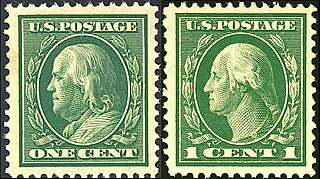
The Washington–Franklin Issues are a series of definitive U.S. Postage stamps depicting George Washington and Benjamin Franklin, issued by the U.S. Post Office between 1908 and 1922. The distinctive feature of this issue is that it employs only two engraved heads set in ovals—Washington and Franklin in full profile—and replicates one or another of these portraits on every stamp denomination in the series. This is a significant departure from previous definitive issues, which had featured pantheons of famous Americans, with each portrait-image confined to a single denomination. At the same time, this break with the recent past represented a return to origins. Washington and Franklin, after all, had appeared on the first two American stamps, issued in 1847, and during the next fifteen years, each of the eight stamp denominations available featured either Washington or Franklin.

The Regular Issues of 1922–1931 were a series of 27 U.S. postage stamps issued for general everyday use by the U.S. Post Office. Unlike the definitives previously in use, which presented only a Washington or Franklin image, each of these definitive stamps depicted a different president or other subject, with Washington and Franklin each confined to a single denomination. The series not only restored the historical tradition of honoring multiple presidents on U.S. Postage but extended it. Offering the customary presidential portraits of the martyred Lincoln and Garfield, the war hero Grant, and the founding fathers Washington and Jefferson, the series also memorialized some of the more recently deceased presidents, beginning with Hayes, McKinley, Cleveland and Roosevelt. Later, the deaths of Harding, Wilson and Taft all prompted additions to the presidential roster of Regular Issue stamps, and Benjamin Harrison's demise (1901) was belatedly deemed recent enough to be acknowledged as well, even though it had already been recognized in the Series of 1902. The Regular Issues also included other notable Americans, such as Martha Washington and Nathan Hale—and, moreover, was the first definitive series since 1869 to offer iconic American pictorial images: these included the Statue of Liberty, the Capitol Building and others. The first time (1869) that images other than portraits of statesmen had been featured on U.S. postage, the general public disapproved, complaining that the scenes were no substitute for images of presidents and Franklin. However, with the release of these 1922 regular issues, the various scenes—which included the Statue of Liberty, the Lincoln Memorial and even an engraving of an American Buffalo—prompted no objections. To be sure, this series presented pictorial images only on the higher-value stamps; the more commonly used denominations, of 12 cents and lower, still offered the traditional portraits.

Charles Ransom Chickering was best known as the freelance artist who designed some 77 postage stamps for the U.S. Post Office while working at the Bureau of Engraving and Printing in Washington, DC. His career as a professional artist began while working as an illustrator for the U.S. Army recording and drawing medical illustrations of the wounded and dead during the First World War. He continued the practice in civilian life and became a noted artist-illustrator who worked for a number of prominent magazines, including The Saturday Evening Post, which were very popular during the pre-television era of the 1920s to 1940s. After the Second World War Chickering began working for the U.S. Post office designing U.S. Postage stamps, some of which became famous. Later in life he became a designer and illustrator for first day cover cachets that were also popular among stamp and postal history collectors.

The Series of 1902, also known as the Second Bureau Issue, is a set of definitive postage stamps in fourteen denominations ranging between one cent and five dollars, produced by the U. S. Bureau of Engraving and Printing and issued by the United States Post Office. Two denominations appeared in November and December 1902 and the other twelve were released between January and June 1903. These stamps were assigned the Scott Catalogue numbers 300 through 313. Also considered part of the series is a fifteenth stamp which appeared in November 1903—a second version of the 2¢ value, the original having faced severe criticism. This series, particularly noted for its exceptional ornateness and opulence of design, remained in circulation until late 1908, when it was superseded by the Washington-Franklin Issues.

The history of Virginia through the colonial period on into contemporary times has been depicted and commemorated on postage stamps accounting for many important personalities, places and events involving the nation's history. Themes are particularly rich in early American and new nation history, historical landmarks, and Virginia-born presidents.

The American Credo postal issues were a series of six commemorative postage stamps issued by the United States Post Office between 1960 and 1961. Issued over a one-year period, the 4-cent stamps feature famous quotes from prominent Americans which are considered to eulogize the principles on which the United States was founded. An opinion poll was taken which consulted one hundred distinguished Americans in public life, which included historians, and presidents of state universities, who collectively chose the given credos found on these stamp issues. The quotes inscribed on the stamps are from George Washington, Benjamin Franklin, Thomas Jefferson, Frances Scott Key, Abraham Lincoln, and Patrick Henry, and were released in that order. Each stamp bears an inscription of the signature of the man who uttered the credo.
